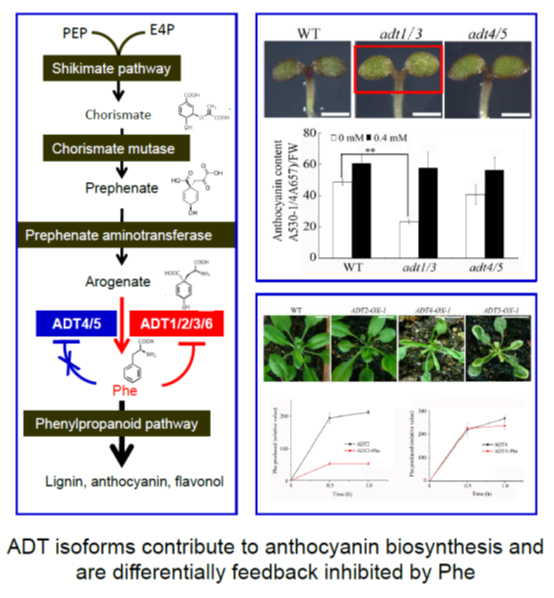A new regulatory mechanism for phenylalanine synthesis in plants
About 25% of the photosynthetic products are stored in phenylpropanoid compounds (such as lignin and flavonoids), which are derived from phenylalanine (Phe). However, the mechanisms by which most photosynthetic products flux into the phenylpropanoid biosynthetic pathway are not fully understood. Phe is synthesized in chloroplasts using chorismate, the final product of the shikimate pathway, as a precursor through three steps catalyzed by chorismate mutase, prephenate aminotransferase and arogenate dehydrotase (ADT). The pathway is conversed in photosynthetic bacteria and plants, and ADT is recognized as a rate-limiting enzyme and feedback inhibited by Phe. The model plant Arabidopsis thaliana genome encodes six ADT genes. However, whether and how these genes contribute to Phe synthesis is largely unknown.
Using genetic analyses, Huang and his colleagues at Shanghai Institute of Plant Physiology and Ecology, CAS Center for Excellence in Molecular Plant Sciences, CAS, found that all six ADT isoforms function redundantly in anthocyanin biosynthesis but have differential contributions in A. thaliana. ADT2 contributes the most to anthocyanin accumulation, followed by ADT1 and ADT3, and ADT4–ADT6. Consistently, addition of Phe to the growth medium could dramatically increase anthocyanin content in the wild-type plants as well as rescue the phenotype of the adt1 adt3 double mutant in the lower level of anthocyanin. These results support that phenylpropanoid biosynthesis is regulated by Phe or metabolic flux.
It has been reported that ADT4 and ADT5 play a dominant role in lignin biosynthesis and their mutation leads to a prostrate phenotype. Interestingly, overexpressing ADT4 or ADT5 but not other ADTs resulted in more anthocyanin accumulated in seedlings, compared with the wild type. Meanwhile, ADT4/ADT5 overexpression lines were dwarf and sterile, which are the same as those observed in Phe overaccumulated mutants. Based on these data, Huang and his colleagues propose that activity of ADT4 and ADT5 is not feedback inhibited by Phe. Indeed, this idea was supported by in vitro enzymatic activity assays showing that ADT4 but not ADT2 was insensitive to Phe. Phylogenetic analysis further showed that ADT4 and ADT5 appeared later than other ADTs and were derived from a gene replication. Taken together, these results suggest that the appearance of Phe insensitive ADT4/5 may be helpful for plants to survive in the upland environment, which needs to be investigated in the future.
The work entitled “Arogenate Dehydratase Isoforms Differentially Regulate Anthocyanin Biosynthesis in Arabidopsis thaliana” was published on the latest issue of <Molecular Plant> pressed on 5th Dec. 2016. This project is financially supported by the National 973 Program and Natural Science Foundation.
CONTACT:
Dr. Jirong Huang, Professor, Institute of Plant Physiology and Ecology, CAS Center for Excellence in Molecular Plant Sciences, Chinese Academy of Sciences, Shanghai 200032, China Tel.: 86-21-54924145, E-mail:
jrhuang@sibs.ac.cn
